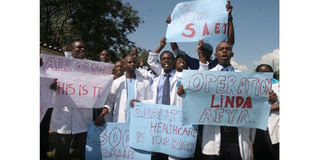Balancing data and populism – the case of health sector

Striking Kisumu doctors during a past protest.
Policy making and leadership decisions are not for the faint hearted. Frequently, observed data contradicts conventional wisdom.
The leader must choose. Pander to latter or deal with data. For political leaders this is a tough choice, for truth may alienate voters.
And nowhere is this more critical than the health sector. The life and death nature makes discussions on the subject very emotive.
The data and science create huge information asymmetry issues between health providers on one hand, and their clients and policy makers on the other. I learned this the hard way in 2018. Sacking doctors who absconded duty gained me both admiration and loathing in equal measure.
The doctors union has once again threatened industrial action, citing among other reasons, shortage of personnel. They are particularly vexed that governments are not employing out of work health personnel. The union must of course look out for the welfare of its members.
That is why it exists. No news there. But health sector leaders, both at county and national level may do well to familiarise themselves with the Service Delivery Indicators Report (SDI), 2019. Prepared by the Ministry of Health and the World Bank, the SDI provides a set of indicators tracking health service delivery in Kenya and other Africa countries.
The Service Delivery Indicator 2019 research covered 3,094 health facilities across all 47 counties. Of these 1,781 were public health facilities covering all levels of service provision from level 2 to level 6. The indicators are one, provider effort, which tracks absence rate (is the nurse, clinical officer or doctor at work) and caseload per provider.
Secondly it tracks provider competence covering diagnostic accuracy, adherence to clinical guidelines and management of maternal and neonatal complications. Thirdly it looks at availability of inputs such as drugs, medical equipment and infrastructure.
The report also has data on roles and responsibilities in the facilities, supervision, leadership, community involvement and fees. For space limitations, I shall only look at one aspect of provider effort – absence.
Absenteeism was at 52.8 percent of all providers both private and public nationally. The public sector performed worse at 56.7%. The 2019 rate is twice as high compared to 2012, when it was 27.5%. Absenteeism is the percentage of doctors, clinical officers and nurses who should have been present but were not, during an unannounced visit to the facility.
Doctors had the highest absenteeism rate of 60.7%, followed by nurses (54.5%) and clinical officers (49.5%). More than half (54%) of the absences were not authorised. Taken together with the doubling of absenteeism suggest serious weaknesses in management and supervision.
Moreover, the absenteeism rate varied greatly between counties. It was lowest in Makueni (25%) and highest in West Pokot (68%). It also varied among cadres.
In Kilifi, Lamu, Murang’a, Embu, Homa Bay, and Turkana counties, all doctors were absent. West Pokot performed worst among clinical officers (78.4 percent), while 81 percent of nurses in Wajir were absent!
So for all those who are charged with making decisions about, and resolving disputes in the health sector human resources – from the labour commissioner, to labour courts to cabinet secretaries for labour and health, and county executive committee members for health, let data inform you.
@NdirituMuriithi is an economist





